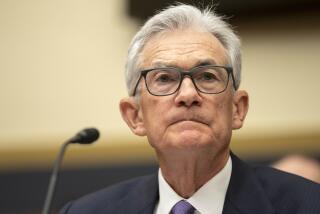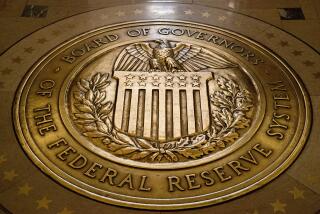More Fed stimulus? Don’t count on it
This isn’t where Federal Reserve Chairman Ben S. Bernanke hoped to be in mid-2011.
Just as the Fed is wrapping up its $600-billion bond-buying program aimed at boosting the economy, the recovery is weakening again, stock prices are slumping and Greece’s fiscal meltdown is threatening to fuel another global financial crisis.
And the other Washington entity with the power of the purse — Congress — seems in no mood to talk stimulus. Just the opposite: Some Republican leaders are threatening to block an increase in the federal debt limit, and risk defaulting on the government’s debts by early August, unless the White House agrees to massive spending cuts.
Just six months ago, some investors had anticipated a far different pickle for the Fed. The expectation was that market interest rates on Treasury bonds would rocket as the central bank neared the end of its purchases on June 30.
Because the Fed has bought the equivalent of virtually all of the Treasury’s net bond issuance this year, it was reasonable to worry whether enough investors would step in once the Fed stepped out.
But the market isn’t worried anymore. Treasury rates are at their lowest levels of the year as more investors worldwide pile into the bonds as a haven amid the economy’s sudden weakness and Europe’s debt woes.
The Fed might have been happy to see bond yields up instead of down if the cause was accelerating economic growth. Instead, with the 2-year-old recovery again stumbling, the Fed faces a large segment of the public that doesn’t believe the central bank has accomplished much, if any, good by creating $600 billion from thin air and pumping it into the financial system via bond purchases since November.
A CNN/Opinion Research Corp. poll this month found that 48% of respondents thought it was either “very likely” or “somewhat likely” that the U.S. would face another depression in the next 12 months.
Not a recession but a depression.
“There’s no question that things are looking very disappointing from the Fed’s perspective,” said Ethan Harris, an economist at Bank of America Merrill Lynch in New York.
Even so, Fed policymakers aren’t going to stress the negatives Tuesday and Wednesday when they hold their first meeting of the summer. Having spent the $600 billion, they can’t very well say, “Oops.”
In a June 7 speech assessing the economy’s prospects, Bernanke spoke broadly about the impact of the Fed’s easy-money policies since 2008. He said the Fed’s moves “doubtless helped stabilize the financial system, ease credit and financial conditions, guard against deflation and promote economic recovery.”
But even as he acknowledged that U.S. growth has been “somewhat slower than expected” this year, Bernanke offered no indication that the Fed was planning another stimulus program. Policymakers are likely to stand pat at next week’s meeting.
Wall Street, which has become accustomed to being rescued, may be holding out false hope for another Fed money injection: Harris said he has been surprised by the number of big investors who have told him recently that they expected the central bank to act quickly if the economy continued to falter and stocks fell hard.
Many Fed watchers say investors should get over that notion. The Fed “wants some breathing room here,” Harris said.
Just the hint of more stimulus could enrage Bernanke’s critics, who say that by flooding the financial system with more dollars he has devalued the currency and stoked inflation in the wrong places, particularly in commodities such as oil.
But a weaker dollar was part of the Fed’s stimulus plan by making U.S. exports less expensive. As for the commodity-price surge since August, the Fed’s answer is that prices have risen since 2008 primarily because of strong fundamental demand from emerging markets, not because of speculation fueled by cheap dollars.
Yet the Fed has been happy to take credit for another form of asset inflation: the stock market’s rally since August. Bernanke has made clear that one goal of the Fed’s stimulus program was to boost financial markets and thereby underpin economic confidence.
The Fed also sought to foster more general inflation, to banish worries that the U.S. could fall into a Japan-like deflationary cycle. Policymakers have gotten what they wanted: The consumer price index was up 3.6% in May from a year earlier, the fastest pace of increase since fall 2008.
The pickup in inflation also argues against another round of Fed stimulus. Charles Plosser, head of the Fed’s Philadelphia bank, said this month that the bar is “very high” to justify more stimulus because of the risk of problematic inflation.
Besides, the Fed, and many economists, insist that the economy is merely in a “soft patch.”
Manufacturing has slowed, but that has stemmed in part from temporary auto-production disruptions caused by a shortage of parts from Japan after the country’s devastating March earthquake. More troubling were reports this week that gauges of manufacturing activity in the New York and mid-Atlantic regions actually contracted in June.
Consumer confidence and spending have been crimped by sky-high gas prices since winter. But oil has fallen 18% since April 29, to $93.01 a barrel on Friday, and average gas prices nationwide are down nearly 8% over the last five weeks.
Both manufacturing disruptions and energy costs “should be less of a drag on the economy when we look at the third quarter,” said Dean Maki, chief U.S. economist at Barclays Capital in New York. He expects real U.S. gross domestic product growth to accelerate from a 2% annualized rate in the current quarter to 3% in the third and 3.5% in the fourth.
On Friday, the Conference Board said its index of leading economic indicators rose 0.8% in May, reinforcing the idea that growth should pick up in the second half.
As for the stock market, blue-chip indexes managed to avoid a seventh straight down week, with the Dow industrials closing up 42.84 points to 12,004.36 on Friday. The Dow added 0.4% for the week. It’s still down 6.3% from its multiyear high reached April 29, but that surely isn’t enough to spook the Fed. A normal “correction” in a bull market could shave 10% to 20% off market indexes.
The Fed may be slow to consider more stimulus for another reason: It still will be reinvesting the proceeds from its total $2.6-trillion securities portfolio in more Treasuries. And the central bank seems certain to keep short-term interest rates near zero for the time being. So in Fed parlance, policymakers remain very “accommodative” for growth.
The economy’s biggest detractors say the recovery has been phony, merely a product of government and Fed borrowing and spending. What Bernanke needs most to prove the bears wrong is for growth to revive this summer without a new prop from the Fed.






